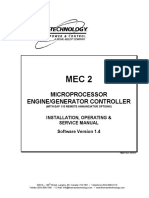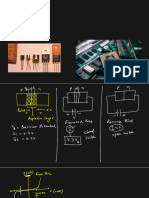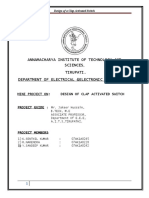I. Objectives
I. Objectives
Uploaded by
Mon Jhio San JuanCopyright:
Available Formats
I. Objectives
I. Objectives
Uploaded by
Mon Jhio San JuanOriginal Title
Copyright
Available Formats
Share this document
Did you find this document useful?
Is this content inappropriate?
Copyright:
Available Formats
I. Objectives
I. Objectives
Uploaded by
Mon Jhio San JuanCopyright:
Available Formats
I.
Objectives:
a. General Objectives:
The general objectives of this experiment is for the students to apply their knowledge
in electronic circuits and devices focusing on Zener diode. The students must show
their skills while performing the experiment and put the Zener diode and its application
to practice.
b. Specific Objectives:
Test and determine if a diode is functioning properly, both in and out of a circuit.
Analyze circuits containing diodes and predict their behavior.
Troubleshoot circuits containing diodes.
Use Zener diodes properly.
Improve in analyzing circuit designs.
II. Abstract:
The zener diode is a semiconductor device unique in its mode of operation and
completely unreplaceable by any other electronic device. Because of its unusual
properties it fills a long-standing need in electronic circuitry. It provides, among other
useful functions, a constant voltage reference or voltage control element available over
a wide spectrum of voltage and power levels. The zener diode is unique among the
semiconductor family of devices because its electrical properties are derived from a
rectifying junction which operates in the reverse breakdown region. In the sections that
follow, the reverse biased rectifying junction, some of the terms associated with it, and
properties derived from it will be discussed fully. The zener diode is fabricated from the
element silicon. Special techniques are applied in the fabrication of zener diodes to
create the required properties.
Numerous electronic circuits require a signal or voltage level to be sensed for circuit
actuation, function control, or circuit protection. The circuit may alter its mode of
operation whenever an interdependent signal reaches a particular magnitude (either
higher or lower than a specified value). These sensing functions may be accomplished
by incorporating a voltage dependent device in the system creating a switching action
that controls the overall operation of the circuit. The zener diode is ideally suited for
most sensing applications because of its voltage dependent characteristics.
III. Background of the Study:
Our group came up with this experiment to demonstrate the characteristic of a
zener diode as a reference voltage element in the circuit. We think that this is helpful for
some electronic equipment to avoid unwanted voltage changes in the circuit that may
damage them. The zener diode we used serves as a reference voltage element in the
circuit, in instance that when the input voltage drops low, the transistor will not conduct
therefore causing high voltage from collector to emitter.
IV. Schematic Diagram:
Figure 1a
V. Simulation:
The zener diode probably finds its greatest use in sensing applications in
conjunction with other semiconductor devices. In both of these circuits the output is a
function of the input voltage level. As the input goes from low to high, the output will
switch from either high to low (base sense circuit) or low to high (emitter sense circuit)
The base sense circuit of Figure 1a operates as follows: When the input voltage is low,
the voltage dropped across R2 is not sufficient to bias the zener diode and base emitter
junction into conduction, therefore, the transistor will not conduct. This causes a high
voltage from collector to emitter. When the input becomes high, the zener is biased into
conduction, the transistor turns on, and the collector to emitter voltage, which is the
output, drops to a low value.
You might also like
- Mec 2 Microprocesador ThomsonDocument90 pagesMec 2 Microprocesador ThomsonNubia ArizaNo ratings yet
- Wound Rotor Induction MotorDocument38 pagesWound Rotor Induction Motorshivamruth24983% (6)
- Build Your Own DS-1 DistortionDocument32 pagesBuild Your Own DS-1 Distortionsebapunk-leiva-arias-9956100% (1)
- SUNTREE Series 5000TL 6000TL 8000TL Grid-Connected Inverter User Manual-EUDocument48 pagesSUNTREE Series 5000TL 6000TL 8000TL Grid-Connected Inverter User Manual-EUmtekpkNo ratings yet
- Smart Street Light System PDFDocument22 pagesSmart Street Light System PDFDevesh SrivastavaNo ratings yet
- Experiment #04: Introduction To Relay and Its Application (Controlling of 220v Using 5v Relay)Document8 pagesExperiment #04: Introduction To Relay and Its Application (Controlling of 220v Using 5v Relay)Ayaz FaisalNo ratings yet
- EE-331 Lab ReportDocument5 pagesEE-331 Lab Reportlaksh rathiNo ratings yet
- EE 211 CHAPTER 2 Part2Document22 pagesEE 211 CHAPTER 2 Part2RickNo ratings yet
- Report of Project-1Document12 pagesReport of Project-103061341753 03061341753No ratings yet
- SssssssssDocument23 pagesSssssssssyohannisyohannis54No ratings yet
- Automatic Battery ChargerDocument36 pagesAutomatic Battery ChargerAurea May Sabater67% (3)
- Project Title: Fabrication of An Automatic Battery Charger Using "SCR"Document36 pagesProject Title: Fabrication of An Automatic Battery Charger Using "SCR"Marsu HardionoNo ratings yet
- LDDocument36 pagesLDM Madan MohanNo ratings yet
- Electronic Circuit Theory: (Mini Project)Document11 pagesElectronic Circuit Theory: (Mini Project)s chethanNo ratings yet
- Pneumatic Based Punching MachineDocument45 pagesPneumatic Based Punching Machineraja100% (3)
- P.E.S. College of Engineering, Aurangabad.: Project ReportDocument25 pagesP.E.S. College of Engineering, Aurangabad.: Project ReportShaikh Ibrahim0% (1)
- Batch 3 Report 18.06.22Document68 pagesBatch 3 Report 18.06.22Sujesh ChittarikkalNo ratings yet
- Remote Control LED: Final ProjectDocument18 pagesRemote Control LED: Final ProjectNoman MustafaNo ratings yet
- Caed Lab ReportDocument6 pagesCaed Lab ReportAakash Devdat KolhiNo ratings yet
- Lab 5 ZenerDocument7 pagesLab 5 ZenerKashif Mujeeb Abdul MujeebNo ratings yet
- Theejaswini PhyDocument22 pagesTheejaswini Phyindianaashika72No ratings yet
- Active & PassiveDocument3 pagesActive & Passivevirendra.aryaNo ratings yet
- Semiconductor Devices 02 ArambhDocument112 pagesSemiconductor Devices 02 ArambhnirenforfunNo ratings yet
- Project Load Protector Final 22Document42 pagesProject Load Protector Final 22virendkumarNo ratings yet
- Eng SakaniaDocument10 pagesEng Sakaniachuck254No ratings yet
- Electric Circuits and Electron Devices (Unit-V)Document38 pagesElectric Circuits and Electron Devices (Unit-V)Dr. N.ShanmugasundaramNo ratings yet
- DiodeDocument20 pagesDiodehabtemariam mollaNo ratings yet
- Voltage Detector Using Any 555 ICDocument8 pagesVoltage Detector Using Any 555 ICPiyush chaudhari100% (2)
- Electronics Code Lock Using One TransistorDocument18 pagesElectronics Code Lock Using One TransistorAnonymous TvXDUWDaol50% (2)
- Experiment No: 1 Familiarization of Electronic Components AimDocument49 pagesExperiment No: 1 Familiarization of Electronic Components Aimarun joseNo ratings yet
- Crystal Diode and Its Basic Application - Docx 222Document10 pagesCrystal Diode and Its Basic Application - Docx 222robin hossainNo ratings yet
- Basic Electronics NotesDocument11 pagesBasic Electronics NotesTricia MerculioNo ratings yet
- Emergency LightDocument12 pagesEmergency LightEysha qureshiNo ratings yet
- Sample Report For ReferenceDocument12 pagesSample Report For ReferenceB41 Nikhil DhumalNo ratings yet
- Automatic Phase ChangerDocument55 pagesAutomatic Phase ChangerGanpati Kucheria75% (4)
- Analog CircuitsDocument32 pagesAnalog CircuitstsangwanNo ratings yet
- Experiment No: 1Document7 pagesExperiment No: 1naeemullah786057No ratings yet
- Broken Wire Detector Circuit Using IC CD4069Document40 pagesBroken Wire Detector Circuit Using IC CD4069olawale gbadebo100% (1)
- Experiment 1Document5 pagesExperiment 1aashishyadav2353No ratings yet
- Electronic Card Lock System Final Year Ece Project ReportDocument17 pagesElectronic Card Lock System Final Year Ece Project ReportSunny Prasanth100% (3)
- Lessons in Electric Circuit2Document84 pagesLessons in Electric Circuit2jun deeNo ratings yet
- 3 EDC Lab ManualDocument73 pages3 EDC Lab ManualVijayalakshmi PrakashNo ratings yet
- AjzKr2fYxgDocument8 pagesAjzKr2fYxgyashtayade13114No ratings yet
- Practical Report: Building A Power SupplyDocument6 pagesPractical Report: Building A Power SupplyRynardt VogelNo ratings yet
- Zener Diode TesterDocument3 pagesZener Diode TesterVijay MirjeNo ratings yet
- Special-Purpose Diodes: Dr. Amnach KhawneDocument39 pagesSpecial-Purpose Diodes: Dr. Amnach KhawneCarlos IbaNo ratings yet
- Full Wave RectifierDocument6 pagesFull Wave RectifierVidushi KochharNo ratings yet
- Workshop Training Manual COURSE: WS1020: Central Workshop Indian Institute of Technology Madras CHENNAI - 600036, INDIADocument44 pagesWorkshop Training Manual COURSE: WS1020: Central Workshop Indian Institute of Technology Madras CHENNAI - 600036, INDIAhariharanhemanthNo ratings yet
- Principles of Electronic Engineering - Unit-1-3Document7 pagesPrinciples of Electronic Engineering - Unit-1-3Ishaan Agarwal TechNo ratings yet
- Esther WriteupDocument12 pagesEsther WriteupOvwero EmmanuelNo ratings yet
- Full Report ET2Document15 pagesFull Report ET2NurulSyafiqahNo ratings yet
- ZenerDocument14 pagesZeneraravindh rhssNo ratings yet
- Presentation On Zener Diode: Submitted byDocument10 pagesPresentation On Zener Diode: Submitted bytej26121994No ratings yet
- Hyundai Electronics TextbookDocument24 pagesHyundai Electronics TextbookMichael IanNo ratings yet
- Zener and Light-Emitting DiodesDocument18 pagesZener and Light-Emitting DiodesLymnuel LibunaoNo ratings yet
- Experiment-1 - To Make A Center-Tap Full-Wave RectifierDocument5 pagesExperiment-1 - To Make A Center-Tap Full-Wave RectifierSKMNo ratings yet
- Qa 00177 Automatic Street Light ControlDocument10 pagesQa 00177 Automatic Street Light Controlashley_rodrigues_20No ratings yet
- 15EI251L E&ilap ManualDocument56 pages15EI251L E&ilap ManualAnushka TantiaNo ratings yet
- Annamacharya Institute of Technology and Sciences, Tirupati. Department of Electrical &electronic EngineeringDocument37 pagesAnnamacharya Institute of Technology and Sciences, Tirupati. Department of Electrical &electronic EngineeringSenthil KumarNo ratings yet
- Instrumentation and ControlDocument34 pagesInstrumentation and ControlMon Jhio San JuanNo ratings yet
- U (V) I (A) P (W) P (W) P (W) P.F G (N) B (M) M (N-M) N (Min) P (W) (%)Document2 pagesU (V) I (A) P (W) P (W) P (W) P.F G (N) B (M) M (N-M) N (Min) P (W) (%)Mon Jhio San JuanNo ratings yet
- AssignmentDocument2 pagesAssignmentMon Jhio San JuanNo ratings yet
- Thermo Chapter1Document11 pagesThermo Chapter1Mon Jhio San JuanNo ratings yet
- EEcicuitsDocument2 pagesEEcicuitsMon Jhio San JuanNo ratings yet
- AccuSine PCS+ - PCSP120D5IP00Document2 pagesAccuSine PCS+ - PCSP120D5IP00sanjayNo ratings yet
- Samsung 2009 PlasmaDocument75 pagesSamsung 2009 Plasmas12originalNo ratings yet
- Edc Unit 5 Small Signal Low Freq BJT ModelsDocument61 pagesEdc Unit 5 Small Signal Low Freq BJT ModelsSandeep PatilNo ratings yet
- Power Factor ImprovementDocument25 pagesPower Factor ImprovementMuskan100% (1)
- DD - Lecture 1 - PCDocument31 pagesDD - Lecture 1 - PCRaju ReddyNo ratings yet
- The ElectroMagnetic Pulse (EMP) and Its EffectsDocument27 pagesThe ElectroMagnetic Pulse (EMP) and Its EffectsDonNo ratings yet
- Chameleon ChipDocument26 pagesChameleon Chipkrushang kananiNo ratings yet
- Irrigation System Specification January 2022Document31 pagesIrrigation System Specification January 2022Tairu HuangNo ratings yet
- Vikram BrochureDocument2 pagesVikram BrochureAmarinder Singh SandhuNo ratings yet
- EE 188 Practice Problems For Exam 1, Spring 2009Document7 pagesEE 188 Practice Problems For Exam 1, Spring 2009Pranav GotenNo ratings yet
- Logic AnalyzerDocument4 pagesLogic Analyzerrashi1704baranwalNo ratings yet
- Chap 4Document30 pagesChap 4Nguyen DanhNo ratings yet
- LM385Document14 pagesLM385vandocardosoNo ratings yet
- Optimal Position Control of A DC Motor Using LQG With EKF: Aravind M. A., Niranjan Saikumar, Dinesh N. SDocument6 pagesOptimal Position Control of A DC Motor Using LQG With EKF: Aravind M. A., Niranjan Saikumar, Dinesh N. SAl-ShukaNo ratings yet
- Matched Filter Precoding: H X H WDocument2 pagesMatched Filter Precoding: H X H WNahQueVer159No ratings yet
- Project List 2024-25Document2 pagesProject List 2024-25Asheem GoswamiNo ratings yet
- Megaprogrammer MC68HC908GP32: by Patrick CarlierDocument21 pagesMegaprogrammer MC68HC908GP32: by Patrick CarlierGiusNo ratings yet
- Chapter 1 Ships Electrical Systems Safety & MaintenanceDocument14 pagesChapter 1 Ships Electrical Systems Safety & MaintenanceBacamarte100% (3)
- QuestHandbook May 2021Document22 pagesQuestHandbook May 2021Pablo FloresNo ratings yet
- Hgsemi-At24c02m-Tr C356696 PDFDocument13 pagesHgsemi-At24c02m-Tr C356696 PDFfiras sonomiNo ratings yet
- Monitor LED HP E223 21.5 4AA7-0717EEEDocument4 pagesMonitor LED HP E223 21.5 4AA7-0717EEEddmaciaseNo ratings yet
- FYP Project Report On StatcomDocument57 pagesFYP Project Report On Statcomgmd technicalNo ratings yet
- MT1769 Full DocumentationDocument25 pagesMT1769 Full Documentationrain.kam86No ratings yet
- Aiwa HS-P06 Brochure USDocument3 pagesAiwa HS-P06 Brochure USVasilica FerneaNo ratings yet
- Audio Level MeterDocument27 pagesAudio Level MeterkrishnayahooNo ratings yet
- PotM 2019 12 Engineering DesignDocument8 pagesPotM 2019 12 Engineering Designgulatimanish1985No ratings yet






























































































